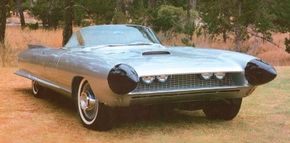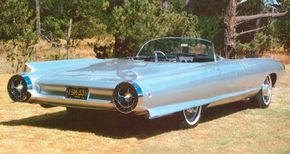The 1959 Cadillac Cyclone was the last "dream car" created during Harley Earl's tenure as General Motors's vice president of design. Compact but flamboyant, the Cyclone marked the end of an era and capped a career that started with Earl's being brought to Detroit in 1926 to design the new LaSalle and resulted in the establishment of styling as a discipline as integral to the car business as engineering or sales.
Earl had spent his professional life trying to make cars look longer and lower. He came to the attention of GM after first becoming known in Hollywood for racy roadsters and elegant limousines built by his father's Earl Carriage Works for members of the wealthy and growing movie colony.
Advertisement
Don Lee, the West Coast distributor for Cadillac, bought the Earl works in 1919, after Harley Earl, Sr., decided to sell due to ill health. Lee put the younger Earl in charge of the shop, and exotic creations began flowing out on expensive deluxe chassis such as Packard, Pierce-Arrow, Rolls-Royce, and, of course, Cadillac.
Lawrence P. Fisher, president and general manager of Cadillac, himself a young man with young ideas, was aware of the growing trend in Europe toward style over utility. Meanwhile, at home, he saw increasing competition from makes like Packard, whose styling was dominant at that time. Fisher was impressed with Earl's designs and asked him to come to Detroit to submit a proposal for the upcoming LaSalle.
The rest is history, as they say, for his proposal was accepted and he stayed through the car's introduction. A year later, General Motors President Alfred P. Sloan, Jr., recognizing the role that design would have on the future of the automotive industry, invited Earl to head up a new section, to be called "Art and Colour."
This name was carefully chosen to avoid causing concern in the engineering departments, whose job it had always been to specify and draw the boxes that had previously passed for automobile bodies. It would be a slow and deliberate process to separate design from engineering, but with successes like the Cadillac V-12 and V-16 in 1930, and the Aerodynamic designs of 1933, Harley Earl secured his position of dominance and proved his worth to the corporation.
For more information on the 1959 Cadillac Cyclone classic car, continue on to the next page.
For more information on cars, see:
- Classic Cars
- Muscle Cars
- Sports Cars
- New Car Search
- Used Car Search
Advertisement




